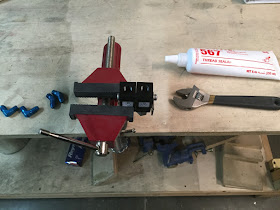Attaching the AN fittings to the parking brake valve using Loctite 567
The completed fitting installation
We then test-fitted the parking brake valve with all four lines connected to it for the first time. It fits perfectly! Now the only thing left with the parking brake valve is to figure out a control mechanism and get the necessary hardware for it. We'll get to that at some point eventually.
In the meantime, it was time to get started assembling the fuel system. I had ordered a number of fittings necessary to put everything together, but I quickly discovered I was in need of just a couple more. No worries, I'll tack them on to the next order from Spruce. Until then, since I had the Loctite 567 out, I could still install a few fittings into the various fuel system components.
The 100-micron fuel prefilters with AN-6 fittings installed
Walbro fuel pump with AN-6 fittings installed
I then made two brackets to attach the fuel prefilters to the landing gear mounts under each seat out of angle aluminum. It went pretty smoothly, and I think I have the finalized fuel system routing/layout figured out. I'll make a diagram here in the next couple days and post on here.
Moving on to see what I could work on, I got back into Section 40 and made 4 little spacers used to attach the flap actuator to its brackets:
The four spacers placed next to their respective steps in the plans
Those spacers were kind of a PITA to make! They are quite small, and it's really hard to hold them square against the bandsaw and belt sander, but with a bit of patience and burnt fingertips we got them made! The dial caliper works really well here to check measurements and end up with a perfectly-sized piece.
The last thing today before calling it quits was to get back to Section 31, Upper Forward Fuselage. We're basically done with that section except for some dimpling and riveting, but I don't want to do too much more until I really finalize my panel layout. So, I clecoed the assembly back together and started with one of my all-time favorite pastimes, avionics daydreaming.
Initial proposed general panel layout
2x Garmin GDU 46x displays, Garmin GMC 307 control panel, and GRT Mini-X backup EFIS
Still LOTS more planning needed for this panel, and even more money to spend on it. The main thing I wanted to do now though is see if I can figure out which parts of the underlying structure will need cutouts and modifications to support the layout I have in mind. I do want to have my autopilot control high and centered, which may require some modifications to the center rib for clearance. I'll need to get some final measurements and start making those cuts. I also need to figure out how I want all the switches laid out. I'd like to keep the panel as symmetrical as possible, and allow for PIC'ing from either the left or right side with minimal difference in usability of the panel. Like I said, lots more to figure out here, but I thought I'd at least share my current thoughts of what I'd like out of this panel.
That's pretty much it for now! I think the plan for tomorrow is to finish up the rear seats, and maybe some other miscellaneous shenanigans... stay tuned!






































